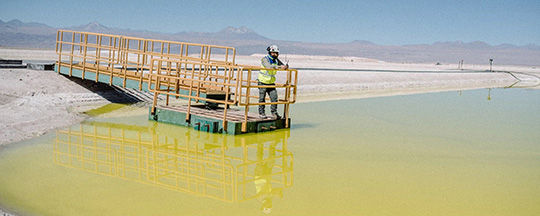Lithium in Brines
The term “brines” refers to any fluid (such as water) containing a high level of dissolved solids. These solids often include sodium and chloride (i.e salt), but also other elements such as calcium, potassium, magnesium, and, if we're lucky, lithium.
How It's Mined
Miners drill into the ground — potentially thousands of feet deep— and pump up briny water into a broad, shallow pool known as an “evaporation pond.” This is the first of multiple ponds that the brine will travel through.
Each pond is chemically treated to separate (or ‘precipitate’) some element in the brines from the rest of the solution. For instance, sodium carbonate may be added to the brines, which changes the pH level (the acidity) of the solution, and causes calcium to settle at the bottom of the pond. At this point, the brines can be pumped to another pond, and the calcium-laden solution left to evaporate in the sun, so the calcium can be collected.

This process is repeated multiple times: moving the brines from one pond to another, and mixing in an agent - such as lime or limestone – to create a chemical reaction that precipitates another element from the brines. These elements can be unwanted impurities that have no use, or they can have value in their own right, such as potassium. As the brines moves along, its ratio of lithium content increases, changing the color of the brines (which explains why evaporation ponds are so colorful, with blues and yellows indicating a high concentration of lithium, up to 6%).
At some point, soda ash is mixed into the solution to finally precipitate the lithium, which is called 'lithium carbonate'. What’s left of the brines can be pumped away, the lithium-rich water left to evaporate, and the remaining lithium carbonate gathered up. It's typically taken offsite to a processing plant for further refinement and cleaning before being sold on the commercial market.

Considerations
Environmental
Accessing the brines means removing that water from the ground, which may adversely affect the water table of nearby areas (sucking up briny water from one area underground may lead to surrounding water flowing into the vacuum, potentially shifting it away from the ecosystems that depend on it). What’s more, evaporation ponds don’t only use water taken from deep underground. They also require large amounts of additional water drawn from environments with existing water scarcity. These and other environmental concerns can lead to project resistance from local communities and lawmakers.
Time
It can typically take from several months to two years to separate lithium from the brines, with unusual rains or dusty winds complicating efforts.
Scarcity
Extracting lithium from brines has only been both geologically and economically feasible in a few places to date. The vast majority of lithium brines mining happens in Chile (roughly 25% of worldwide lithium production), in the Atacama Desert, which is a massive basin with very high temperatures and a very short rainy season. Over millions of years, the basin gathered up rain water filled with minerals including lithium, and the extreme heat quickly evaporated the water, leaving high concentrations of lithium to be buried by the winds and following runoffs. Nearby regions of Argentina and Bolivia have similar geological characteristics and histories, leading to the region being called the 'The Lithium Triangle'. But even then, Argentina's output is roughly 25% of Chile's, and Bolivia, which has yet to produce lithium, is not expected to have Chile's productivity either, with greater impurities in its deposits and a rainy season that lasts several months.
Outside of the Lithium Triangle, very few other areas of the world have the geological history and hot and dry climate today to drive efficient evaporation efforts. For instance, there is only one brines operation in all of North America (the Silver Peak mine in Nevada's Clayton Valley, which produces roughly 5% of Chile's output).
Noteworthy Projects
• Atacama Desert, Chile (SQM, Albermarle Corp)
• Northern Argentina (Gangfeng Lithium, Livent Corp)
• Clayton Valley, NV (Albermarle Corp)
Future Developments
Lithium extration from brines may be on the verge of significantly expansion thanks to a new set of technologies known as 'Direct Lithium Extraction' (DLE). The promise of DLE is that it can extract lithium directly from brines without the need for evaporation. It's an early-stage process that has not been deployed at commercial scale, but the next few years will provide some real-world data regarding its impact on the industry. See our DLE page here.
